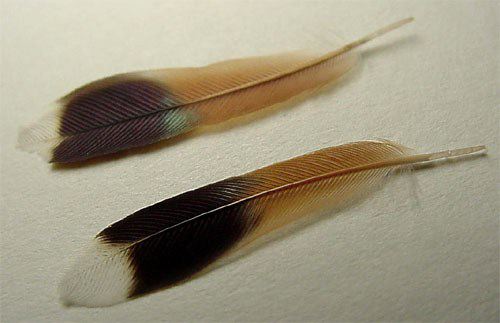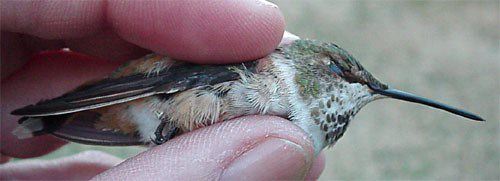 HOME: www.hiltonpond.org |
|||
|
RUFOUS HUMMINGBIRD |
 Old friend Pete Worthington of Simpsonville SC, a past member of the South Carolina Ornithological Records Committee, always has his ear to the ground for rare birds in the state. When his fellow church-goer, Bill Greer, mentioned a few weeks ago that a hummingbird had been coming to his backyard feeder since mid-November, Pete was both pleased at the report and a bit jealous, since Bill lives not far from Pete and Pete didn't have a winter hummer of his own to brag about. Nonetheless, Pete sent us an e-mail about Bill's hummer, and we arranged to visit Simpsonville (Greenville County) early on the morning of 11 February 2003.  Bill Greer has been feeding hummingbirds longer than most of us, having started 40 years ago in when he lived in Tennessee. Being aware that winter hummers are rare and worthy of further study, he and wife Sarah welcomed us warmly. We arrived at the Greer home at about 7 a.m., set up our portable trap, placed Bill's feeder within it, walked toward the back porch, saw the hummer enter the trap, and pushed our remote triggering device before we even got the screen door open--making the 45-second wait our fastest trapping episode ever for a winter hummingbird. Too bad they aren't all that easy.  As we approached the trap, we saw rusty coloration at the base of the bird's tail, implying that it was a Selasphorus hummingbird--either Rufous or Allen's. We also noticed that several of the bird's tail feathers (rectrices) were missing, a sign that it might be undergoing a mid-winter molt. As were carefully grasped the bird for banding, a few more rectrices fell out--not an uncommon occurrence at this time of year for winter hummers in the eastern U.S. (see top photo).
On one occasion in early February, Bill saw a hummingbird dive bomb the feeder while another was drinking, so he was positive he actually had TWO hummers. Pete thought he, too, had seen a second bird, so we re-set the trap and waited for it to appear. Indeed, within 30 minutes or so, a hummingbird with what appeared to be a complete set of tail feathers approached the trap but didn't enter; when this possible second bird did not return within the next two hours, we regretfully packed up our gear and returned to York.  Thanks to Bill and Sarah Greer for allowing us to visit and trap their Rufous Hummingbird, and to Pete Worthington for alerting us and sharing his morning as we banded the Simpsonville hummer. Age/Sex--After hatch year female Weight--3.84g Wing Chord--43.4mm Tail Length--25mm Tail Fork--not measurable Culmen (upper bill)--18mm Bill Corrugations--None Gorget--10+ orange-red metallic feathers
If you're interested in sharing your hummingbird observations and learning from other enthusiasts, you may wish to subscribe to Hummingbird Hobnob, our Yahoo!-based discussion group. Also be sure to visit our award-winning Web site for Operation RubyThroat: The Hummingbird Project; on it you'll find almost anything you want to know about hummingbirds, including more information about Hummingbird Banding.
For much more information about hummingbirds, visit Operation RubyThroat: The Hummingbird Project  |
 The width of the bird's tail feathers--both loose and attached--were relatively wide, which suggested this was a Rufous Hummingbird, and the body size and plumage implied female. (Allen's Hummingbirds tend to have very narrow rectrices, and male Rufous hummers resemble but are smaller than females of their species.) We confirmed our suspicions by making a series of measurements, including wing and bill. After banding, we inserted the hummer's bill into the feeder port and watched as the bird drank readily, after which Bill Greer released his winter hummingbird (bottom photo).
The width of the bird's tail feathers--both loose and attached--were relatively wide, which suggested this was a Rufous Hummingbird, and the body size and plumage implied female. (Allen's Hummingbirds tend to have very narrow rectrices, and male Rufous hummers resemble but are smaller than females of their species.) We confirmed our suspicions by making a series of measurements, including wing and bill. After banding, we inserted the hummer's bill into the feeder port and watched as the bird drank readily, after which Bill Greer released his winter hummingbird (bottom photo).

 Students at GLOBE-certified schools may submit winter hummingbird observations as part of Operation RubyThroat and GLOBE. Students can also correlate hummingbird observations with data on abiotic factors, including atmosphere, climate, hydrology, soils, land cover, and phenology. See the
Students at GLOBE-certified schools may submit winter hummingbird observations as part of Operation RubyThroat and GLOBE. Students can also correlate hummingbird observations with data on abiotic factors, including atmosphere, climate, hydrology, soils, land cover, and phenology. See the 


